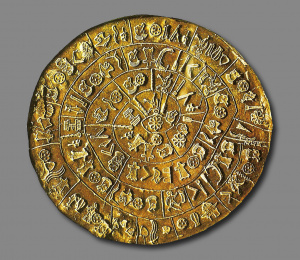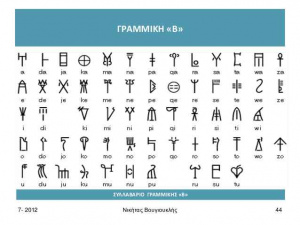Language/Ancient-greek-to-1453/Grammar/Greek-writing-through-time
Συστήματα oγραφής που αναπτύχθηκαν στην Ελλάδα με την πάροδο του χρόνου.
Hello Greek learners,
In this lesson, you will learn how Greek writing has been evolving over time.
This lesson is in 3 languages: Greek, English and French.
Happy learning!
| Ελληνικά | English | Français |
|---|---|---|
| Συστήματα γραφής που χρησιμοποιήθηκαν στον ελληνικό χώρο | Greek writing through time | L'écriture grecque à travers le temps |
| 1. Ιερογλυφική γραφή (περίπου 2000-1750 π.Χ.)
Πρόκειται για εικονογραφική γραφή. Χρησιμοποιήθηκε κυρίως σε σφραγιδόλιθους που βρέθηκαν κατά τις ανασκαφές τού Evans στην Κνωσό. Η γραφή αυτή δεν έχει ακόμη αναγνωσθεί. |
1. Hieroglyphic writing (c. 2000-1750 BC).
This is an iconographic writing. It was mainly used in seal stones found during the excavations of Evans in Knossos. This writing has not yet been read. |
1. Écriture hiéroglyphique (vers 2 000 – 1 750 av. J.-C.)
Il s'agit d'une écriture iconographique. Elle a été principalement utilisée dans les pierres de phoque, trouvées lors des fouilles d'Evans à Cnossos. Cette écriture n'a pas encore été déchiffrée. |
| 2. Γραμμική γραφή Α΄ (περίπου 1700-1450 π.Χ.)
Πινακίδες τής γραμμικής Α΄ βρέθηκαν κυρίως στην Αγία Τριάδα τής Κρήτης. Μολονότι μοιάζει με τη Γραμμική Β΄, δεν έχει ακόμη αναγνωσθεί. Αποτελεί πρόβλημα αν η Γραμμική Β΄ είναι εξέλιξη τής Α΄ ―επειδή σε πολλά σημεία είναι πολυπλοκότερη― ή αν και οι δύο αποτελούν εξελίξεις από άλλον κοινό τύπο γραμμικής γραφής. |
2. Linear writing AD (c. 1700-1450 BC)
Signs of linear AD were found mainly in the Holy Trinity of Crete. Although it resembles Linear BD, it has not yet been read. It is a problem if Linear B is an evolution of A. Because in many places it is more complicated or if both are developments from another common type of linear writing. |
2. La linéaire A’ (vers 1 700 – 1 450 avant J-C)
Une écriture, encore non déchiffrée. Les tableaux de linéaire A’ ont été trouvés principalement dans le village Sainte Trinité en Crète. Bien que l’écriture ressemble à la linéaire B’, elle n'a pas encore été déchiffrée. Il est problématique de savoir si la linéaire B’ est une évolution de A ΄ car à bien des égards, elle est plus complexe - ou si les deux sont des développements à partir d'un autre type commun d'écriture linéaire. |
| 3. Γραμμική γραφή Β΄ (περίπου 1450-1200 π.Χ.).
Η Γραμμική γραφή Β΄ βρέθηκε στην Κνωσό και την Πύλο. Υποστηρίζεται πως η Γραμμική Β΄ είναι φωνητική γραφή συλλαβικού χαρακτήρα. Εξαφανίστηκε με την πτώση των μυκηναϊκών ανακτόρων γύρω στο 1300 π.Χ., αλλά επιμένει και επιβιώνει στην Κύπρο, και είναι η λεγόμενη Γραπτό-Μινωική γραφή. |
3. Linear writing BD (c. 1450-1200 BC).
Linear BD was found in Knossos and Pylos. It is argued that Linear BD is a syllabic phonetic writing. It disappeared with the fall of the Mycenaean palaces around 1300 BC, but it persists and survives in Cyprus, and is the so-called Written-Minoan script. |
3. Écriture linéaire B΄ (vers 1 450 – 1 200 avant J-C).
L'écriture linéaire B à Cnossos et à Pylos. On a supposé que le linéaire B est une écriture phonétique de caractère syllabique. Elle disparaît avec la chute des palais mycéniens vers 1300 avant notre ère, mais elle persiste et survit à Chypre. Elle devient l’écriture Chypro-minoenne. |
| 4. Κυπρομινωική γραφή (περίπου 1500-1100 π.Χ.).
Παλαιά ευρήματα τής εποχής του χαλκού από την Έγκωμη τής Κύπρου. Δεν έχει ακόμη αναγνωσθεί. |
4. Cypriot-Minoan script (c. 1500-1100 BC).
Old finds from the Bronze Age from Engomi, Cyprus. Not yet read. |
4. Écriture chypriote-minoenne (vers 1 500 - 1100 avant J-C).
Anciennes trouvailles de l'âge du bronze, inventées à Engomi, en Chypre. Elle n’a pas encore décryptée. |
| 5. Κυπριακό συλλαβάριο (περίπου 6ος-4ος αι. π.Χ.).
Ατελής συλλαβογραφική γραφή με 56 συλλαβογράμματα. Μοιάζει με τη Γραμμική Β΄, στης οποίας την αποκρυπτογράφηση βοήθησε αρκετά. Παραμένει άγνωστη η σχέση των δύο γραφών. Έχει αναγνωσθεί. |
5. Cypriot syllabary (c. 6th-4th century BC).
Incomplete syllabary writing with 56 syllabaries. It is similar to Linear BD, in which decryption helped a lot. The relationship between the two writings remains unknown. It has been read. |
5. Syllabaire chypriote (vers le 6e-4e siècle avant J-C).
Écriture syllabaire incomplète ayant 56 syllabaires. Elle est similaire à la Linéaire B’, dans laquelle son déchiffrement a beaucoup aidé sa compréhension. La relation entre les deux écrits reste inconnue. |
| 6. Ελληνικό αλφάβητο (περίπου. 10ος αι. π.Χ. – σήμερα)
Έτσι αποκαλείται το αλφάβητο που διαμορφώθηκε με επινόηση των Ελλήνων περίπου τον -10ο π.Χ. αι. Οι Έλληνες είναι οι πρώτοι που, παίρνοντας τα βασικά στοιχεία από το βορειοσημιτικό σύστημα γραφής (κυρίως τα σύμφωνα), διαμόρφωσαν δικό τους σύστημα, στο οποίο κάθε γράμμα αποδίδει έναν φθόγγο. Έτσι δημιούργησαν το πρώτο πραγματικά συστηματικό φωνολογικό αλφάβητο, το οποίο είναι διεθνώς γνωστό ως ελληνικό αλφάβητο. |
6. Greek alphabet (c. 10th century BC - today)
This is the name of the alphabet that was formed with the invention of the Greeks around -10th BC. ai. The Greeks were the first to take the basic elements from the northern signature writing system (mainly the consonants), formed their own system, in which each letter gives a consonant. So they created the first truly systematic phonological alphabet, which is internationally known as the Greek alphabet. |
6. Alphabet grec : du 10e siècle avant J-C jusqu’à aujourd'hui .
Ainsi est nommé l'alphabet qui a été inventé par les Grecs vers le 10ème siècle avant J-C. Les Grecs étaient les premiers à former leur propre système, en prenant les éléments de base du système d'écriture sémitique du Nord (principalement les consonnes), dans lequel chaque lettre donne un phonogramme. Ils ont donc créé le premier alphabet phonologique véritablement systématique, connu internationalement sous le nom l'Alphabet grec. |
| «Το ελληνικό αλφάβητο: Αλφάβητο – γραφή – ορθογραφία» Γ. Μπαμπινιώτης. | "The Greek alphabet: Alphabet - writing - spelling" G. Babiniotis.
Picture: Nikitas Vougiouklis |
"L'alphabet grec: Alphabet - écriture - orthographe", Professeur : G. Babiniotis, |
| Εικόνα : Νικήτας Βουγιουκλής | Photos de : Nikitas Vougiouklis |
Author[edit source]
- Ευγενική χορηγία που στοχεύει να βοηθήσει μαθητές ή μη, απανταχού της Γης, που επιδίδονται στην εκμάθηση της ελληνικής γλώσσας!
- Contribution bénévole visant à aider les personnes, partout dans le monde, qui sont engagées dans l'apprentissage de la langue grecque !
- Voluntary contribution aimed at helping people, all over the world, who are committed to learning the Greek language!
Source[edit | edit source]
Other Lessons[edit | edit source]
- Ancient Greek First Declension
- Possessive pronouns
- Accents in Ancient Greek
- Gender
- Defined or repetitive pronoun
- Plurals
- The verb : εἰμί
- Structure and constituents of verb
- Demonstrative Pronouns
- Ancient Greek Adverbs


